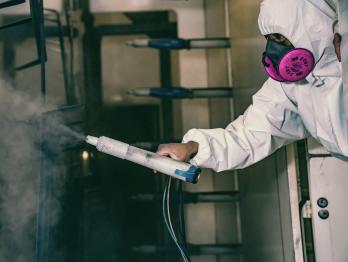
POWDER COATING VS. WET PAINTING
Share
When it comes to deciding on powder coating or painting for your project, there are many factors to consider. Will the product be out in the elements? Will the part be exposed to mechanical stresses? Is the thickness of the finish an issue? Do you need custom color work?
There’s no one finish that’s always better in all situations. Here’s how powder coating and wet painting compare across several key areas, to help you weigh your options.
FIRST, WHAT IS POWDER COATING?
In the powder coating process, dry powder particles are electrostatically charged onto the product or part surface. This “powder coating” is then cured in a specialized oven, where the powder melts into a gel and coats the surface. The result is a thick, even and durable finish.
WHAT IS LIQUID PAINTING (WET PAINTING?)
In this process, liquid paint is wet-blasted onto the product or part surface using a spray, pump or pressurized vessel. The paint is applied until the surface is evenly coated to the desired thickness.
FINISH CONSISTENCY & COVERAGE
Powder coats are usually a one-pass finish. Because the coating is created by heating the powder into a gel, there are no drips, runs or application marks. This produces a remarkably even, consistent finish. Powder coatings are also supplied ready for immediate use without the need for pre-mixing, stirring, solvent additions or viscosity adjustments, so variations are minimized.
Achieving an even finish with wet paint is trickier, often requiring multiple coats. Complete coverage is also difficult with solvent based sprays.
DURABILITY & CORROSION RESISTANCE
Powder coating produces a thick, dense finish that is more durable and longer lasting than standard wet painting. Painted surfaces may require maintenance and refinishing sooner. That’s why powder coating is often the choice for parts and products that are exposed to environmental and mechanical stresses.
One of the main advantages of powder coating is its superior corrosion resistance. It delivers high film builds and good edge coverage, as well as high crosslink density, good resistance to hydrolysis, low moisture and oxygen transmission rates, and films free from any traces of residual solvents.
FILM/FINISH THICKNESS
While powder can be applied over a wide range of film thicknesses, powder coating by and large produces a dense, thick finish. It can be difficult to achieve a thin finish without negatively affecting the finish texture. Powder coating is commonly applied between 2-3 mils across many commercial and industrial applications.
Wet paint can produce a much thinner finish. This meets the finishing needs of products that demand a thin finish.
COLORS & TEXTURES
Powder coating can be done in many different colors and textures, including custom finishes. Liquid paint, however, comes in a wider range of colors and can be mixed to create far more. Some custom color work may require wet painting.
ENVIRONMENTAL IMPACT
Unlike liquid painting, powder coating is free of VOC outgassing, making it much easier on the environment compared to liquid paints. Less paint is wasted, too, due to the efficiency of the coating process.
TO RECAP...
Powder Coating
- Often used for parts and products exposed to environmental and mechanical stresses
- Extremely durable and long-lasting with many formulations exceeding 1000 hours for ASTM standard salt sprays
- Not suitable for most temperature sensitive surfaces as typical temperatures reach 350 - 400°F (although low-temperature powders are available)
- Superior corrosion resistance
- Thick, dense finish
- Even finish without drips or application traces, usually in one pass
- Good edge coverage
- Eco-friendly
- More complex process that requires specialized equipment (electrostatic booth, curing ovens)
Wet Painting/Liquid Painting
- Used for a wide variety of products
- May require more frequent refinishing and maintenance over time
- Can be used when products can’t be heated
- Can be used when parts have too much mass to efficiently heat and cure
- Applicable for products that demand a thin coating/finish
- Often requires multiple coats to get a smooth, even finish
- Can produce a wide range of colors and effects for custom jobs
- Requires less speciality equipment but is more labor intensive
- May be preferred solution for large or bulky items too large to fit in common oven sizes
Considering powder coating? Our experts can help you choose the best finish for your project. Give us a call or Request a Quote now.